![]()
THE PRO-FILE
THE ANATOMY OF THE VOICE (Part One)
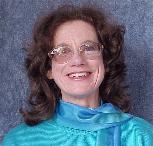
|
About forty years ago Jo Estill began exploring the physiology of the voice. Her work was significantly aided by the development of fibre-optic technology that for the first time enabled the larynx to be observed working naturally. The results are of great benefit to singers and actors. New Zealander Linda Cartwright has an enthusiastic interest in Jo Estill's discoveries. She is a specialist voice teacher whose process is strongly influenced by Jo Estill's work. Linda is Voice Tutor for the Acting Major at the Unitec School of Performing and Screen Arts in Auckland. |
|
|
Linda: Jo Estill is now an elderly lady - she is about eighty. She's an American of Italian parentage … and the whole thing started I think because she was a singer - a gifted natural singer - and when she was twenty or so she was taken to Denmark, I think it was, to have her European debut as a singer. She had a beautiful voice and so there was a lot of razzmatazz about it. Now I don't know the reason why … but apparently she got cold feet and gave up the whole thing. She then went back to America, got married, had children and apart from singing around the house didn't do anything until she was about forty when she happened to be going to university and the university she was at was starting to explore "voice science". Because of her interest in singing she decided to study this subject.
| I think gifted teachers have been using things that will achieve the technical results that Jo achieves for centuries but what is new is that since the advent of fibre-optics we have actually become quite advanced in understanding what happens at laryngeal level. These days they can put this little tube up your nose and down your throat and you can sit there and see your vocal folds performing on a monitor while you are actually making the sounds. You can sing, speak, scream, cry, sob or whatever … and on the monitor you can see exactly how you are doing it. Whereas before fibre-optics they had to anaesthetize you, which was tantamount to having a cup of cold tea splashed into your lungs, and then you would be laid out on a table with a thing put down your throat. |
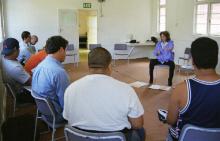 Linda giving a class on Shakespearean text to 2nd Year students at Aucklands School of Performing & Screen Arts |
You didn't get to see it and I don't think an anaesthetized larynx would behave in the same way as an ordinary one.
This (new) technology is largely of great use to singers but because it's just technical scientific stuff it is also of great use to anyone using the voice. It's nothing to do with the 'art' of voice work. It's nothing to do with shaping and phrasing and all the other things that voice teachers do to help actors sit in the moment by sitting in their voice. But it does clearly show the mechanics of how the voice works.
You see the larynx really is a valve - that's its primary function … although we now use it to make sound and that's called an adaptive function …(I think it was about one hundred and fifty thousand years ago that we started to do this) … but as I was saying it's basically a valve that stops breath or lets breath through and we use what we call the 'true folds' to vibrate over the 'out breath' and produce sound. Now one of the big things of vocal abuse is what Jo calls constriction of the larynx. And they have found out that just above the 'true folds' that vibrate and create the sound, you have two masses of what is partly muscle but largely fatty tissue called the ventricular or 'false folds'. Now because it's a valve … the larynx does its thing, which is to close and open … and they have realized that the ventricular folds can come across and actually clamp the whole larynx. That's what Jo calls constriction.
Richard: So the larynx is actually the mechanism which opens and closes the air ways into the lungs?
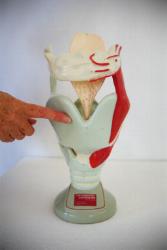 Linda indicates the position of the thyroid cartelage on a model of the larynx. |
Linda: Absolutely. Now what you do with the larynx will alter the type of sound you create. For example, opera singers learn that to get vibrato and to get an 'opera singer sound' you tilt the thyroid cartilage forward. Because the true folds are joined onto it … if it is tilted foreward, the folds are stretched and you get an 'opera' sound … If however you want to 'belt' you don't tilt that. To 'belt' you get the cricoid cartilage … it has the arytenoids sitting on top of it so that the vocal folds are attached to that … and you tilt it … then you're more likely to get a 'belt' sound like Shirley Bassey. It's a shout on pitch really … and for a long time opera singers have been very wary of 'belting' because they felt it might damage the voice. Now Jo Estill says you can 'belt' till the cows come home as long as you do the things that the larynx needs … one of which is to anchor it with muscles in the back to hold it stable. This makes sure your voice isn't wobbling all over the place because it stops the larynx wobbling. |
Because, getting back to constricting … the big thing that gets in the way I suppose is that those false folds come together in response to effort. Now anything in performance mode is deemed effort by the larynx because you are actually working at a louder level … a louder way of speaking. So you have to be very careful that you don't constrict. If you do you can stuff up the 'true folds' - they won't work as well - and eventually you could get vocal nodules and that sort of thing. This is not desirable.
There's one exercise I do with students where I get them to run around the room and I say to them, "Just make the most dynamic sound you can" - and very often I get really tight and constricted sound where not only is the larynx squidging but the false folds have really come across and stopped the sound. So one of the first things you learn is how to actually open that constriction. You start to learn with the Estill work that because the larynx is just sitting in your neck … its held in place by a total hammock of muscles going every which way … it means that everything you do with posture, everything you do with your face and with your shoulders will affect it. And you learn scientifically what is going on.
The other thing that the Estill work does is show you all about different vocal qualities. For example speech quality is thick folds with the thyroid and the cricoid cartilage absolutely square. For speech you don't need any tilting. But you learn that speech is stronger in the lower part of the range and once you get up higher you alter conditions in the larynx so you really have to watch what happens here because you can either go squeaky or you can get for example what a lot of women get - a falsetto quality.
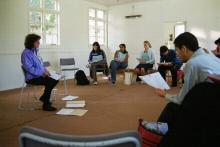 You
also learn how to get a bit of 'twang' in the voice and you learn
what creates the thing they call 'twang'. And here again it's
probably what other speech teachers have maybe called nasal resonance.
But because they have done scientific observations on it you
realize what twang is caused by … there's an opening to
the top of the larynx called the aryepiglottis sphincter …
and they have worked out that if that is tight and it's pulled
tight like a purse string … it gets to about one sixth of
the diameter of the throat (the pharynx) that it's opening in
to and you get that ring to the voice. Now, in opera singing
its called 'squillo' but we also like it in spoken word voices.
You
also learn how to get a bit of 'twang' in the voice and you learn
what creates the thing they call 'twang'. And here again it's
probably what other speech teachers have maybe called nasal resonance.
But because they have done scientific observations on it you
realize what twang is caused by … there's an opening to
the top of the larynx called the aryepiglottis sphincter …
and they have worked out that if that is tight and it's pulled
tight like a purse string … it gets to about one sixth of
the diameter of the throat (the pharynx) that it's opening in
to and you get that ring to the voice. Now, in opera singing
its called 'squillo' but we also like it in spoken word voices.
Richard: You are talking about inner parts of the anatomy … So how do you learn to manipulate these if you can't see them?
Linda: Well you can see them if you are 'on scope' …. Um….
Richard: So do you have a 'scope' here?
Linda: Oh, no! You would have to have that done by an otolaryngologist. But it is in fact very easy. You can actually start to feel what is happening in your larynx. At first you think "My what? What is this person asking me to do?" But as you get more familiar with how it feels you can actually get quite specific about it. And one of the ways we develop twang quality is to get people … in New Zealand where every knows about sheep … they can make a "baa-aa-aa" sound. Oddly enough that is getting the right effect in the larynx.
I talk about twang a lot because of course for actors on the stage it actually gives an upper harmonic to the voice … it gives that cutting edge to the sound. Because speech quality as speech quality doesn't carry very far … it can go quite muzzy so you need a little bit of twang in it.
Richard: That helps projection, does it?
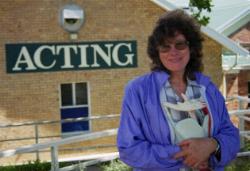 Linda: Absolutely. Again, as I say, I
think there were gifted teachers way back in the 1800's who had
an intimation of what was going on … they often used metaphors
(to explain things)… they would always say to singers "Open
your throat" … but how do you open your throat? People
could be going overboard on it, pushing the tongue down and so
on … when what they are really trying to do is retract the
false folds … to get the larynx really clear so that it
just does its stuff … so it's not new in some ways, it's
just newly scientifically proven and Jo has set it out so logically
- that does make a difference.
Linda: Absolutely. Again, as I say, I
think there were gifted teachers way back in the 1800's who had
an intimation of what was going on … they often used metaphors
(to explain things)… they would always say to singers "Open
your throat" … but how do you open your throat? People
could be going overboard on it, pushing the tongue down and so
on … when what they are really trying to do is retract the
false folds … to get the larynx really clear so that it
just does its stuff … so it's not new in some ways, it's
just newly scientifically proven and Jo has set it out so logically
- that does make a difference.
More information about Jo Estill is available from Estill Voice Training Systems http://www.evts.com/
In the second
part of this interview Linda Cartwright explores the concepts
of audibility and clarity. She also discusses the value of this
process for actors who sometimes have to sing and the time frame
involved for students in learning the Estill concepts.
< BACK TO THE PRO-FILE
INTRO | ABOUT | WORKSHOPS & CLASSES | TESTIMONIALS | LATEST NEWS | WORKING ACTOR
GREENROOM | DIRECTOR'S NOTES | QUOTARIUM | DIARY | OFF-CUTS | AUDITIONS | CONTACT
All contents copyright © The Rehearsal Room unless othewise stated
|
|
|
|
||||||
|---|---|---|---|---|---|---|---|---|
|
|
|
|
||||||
|
|
|
|